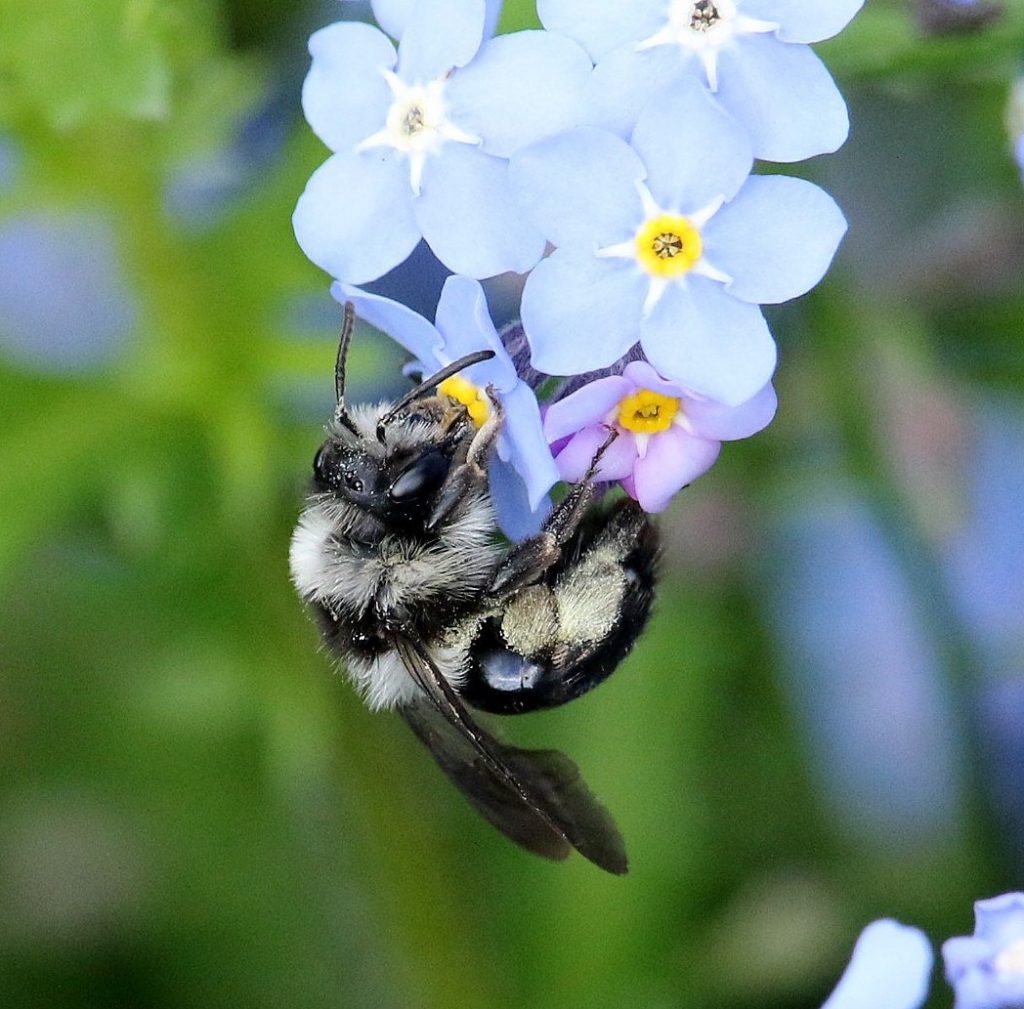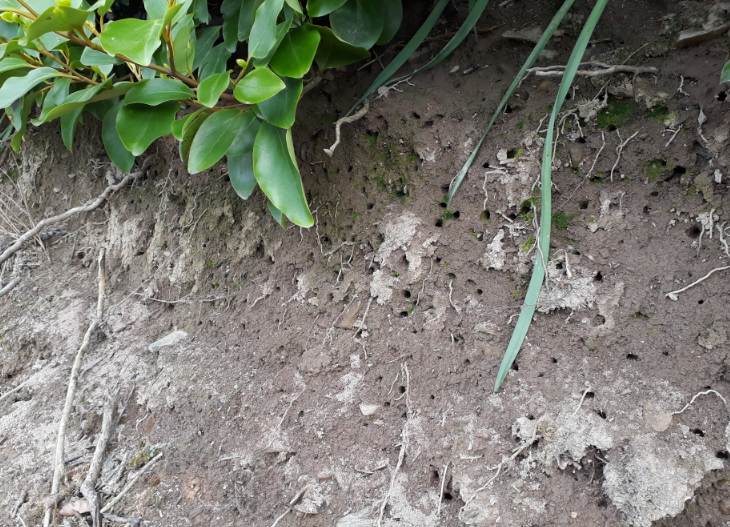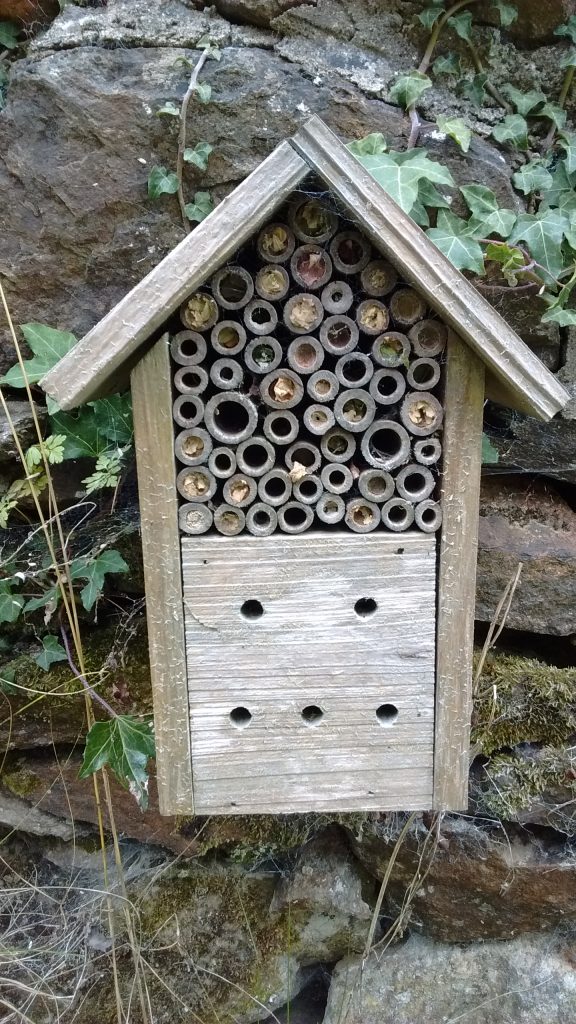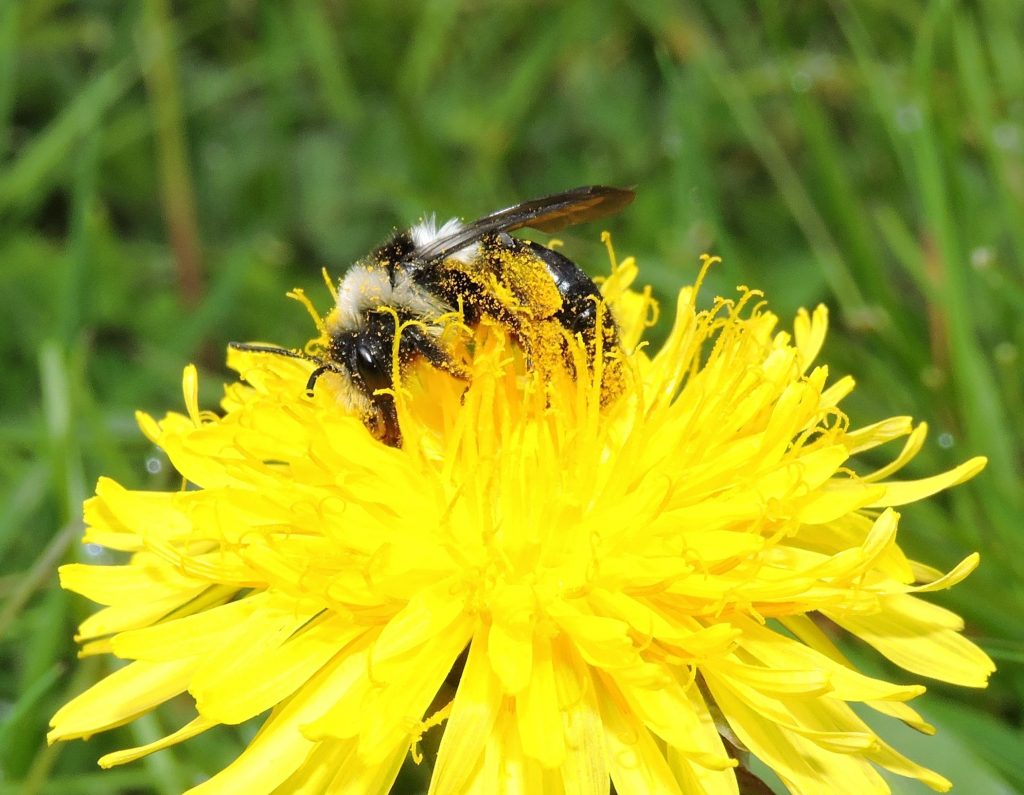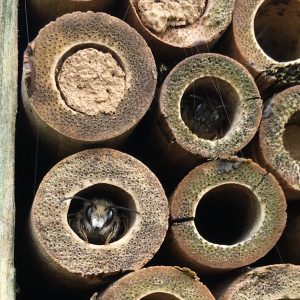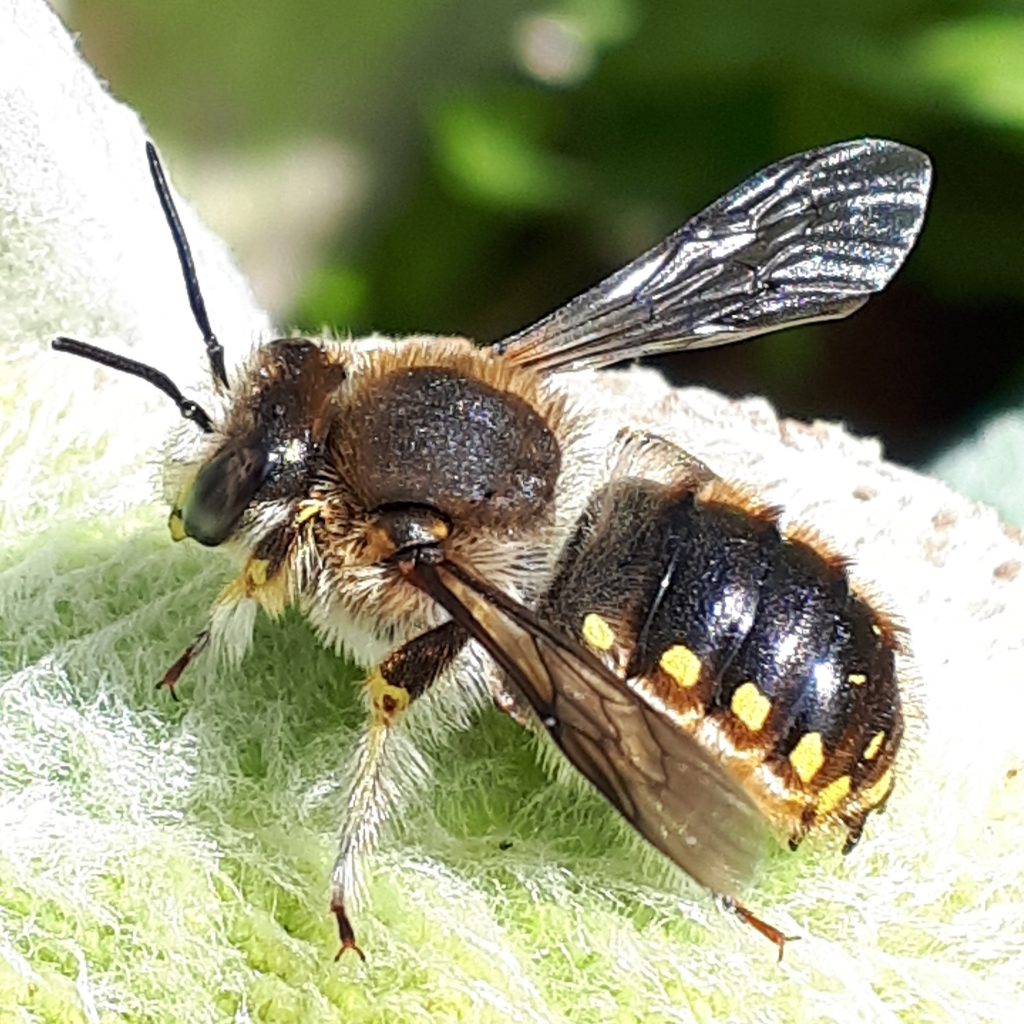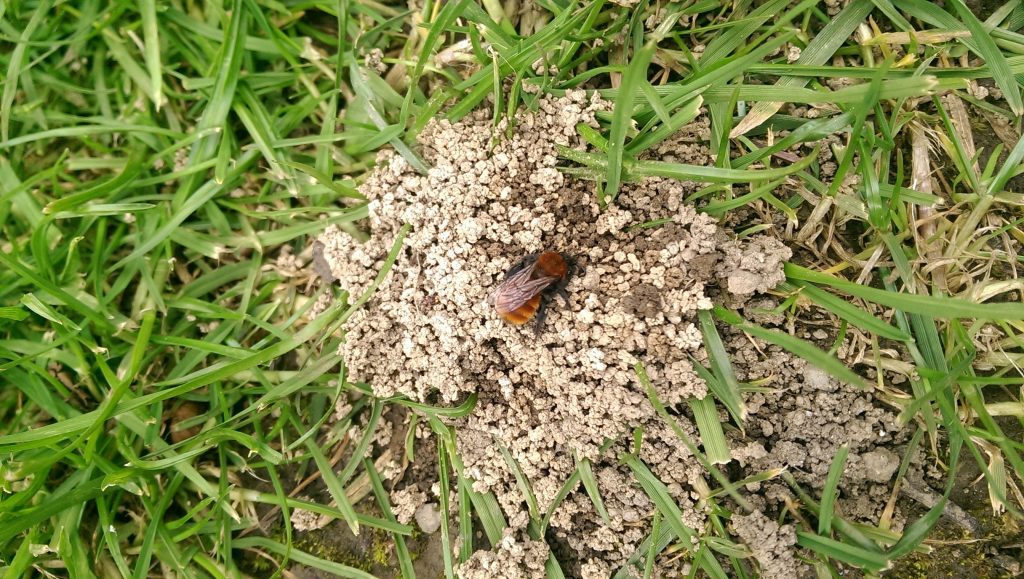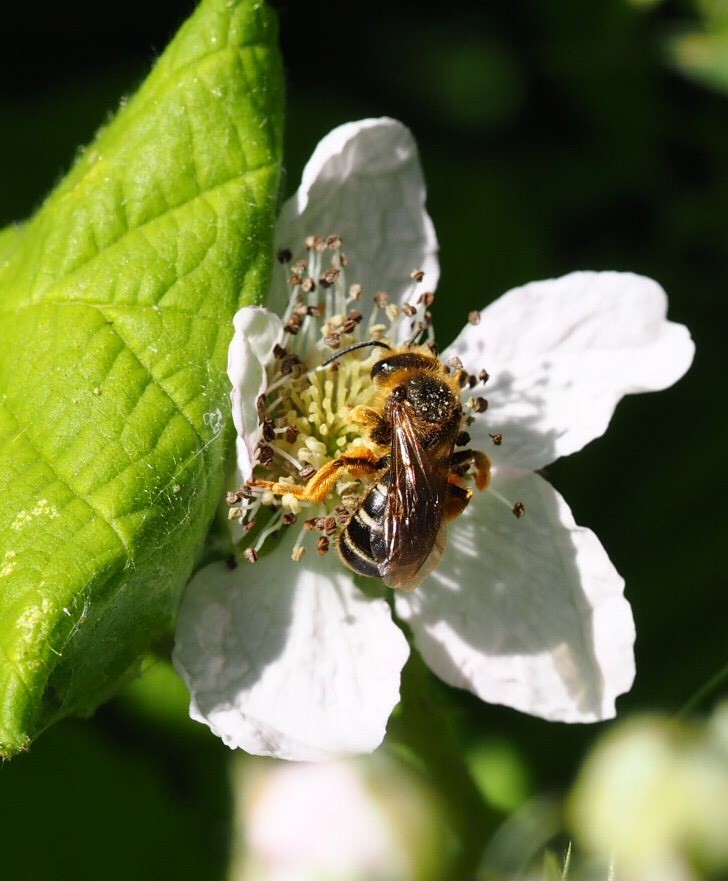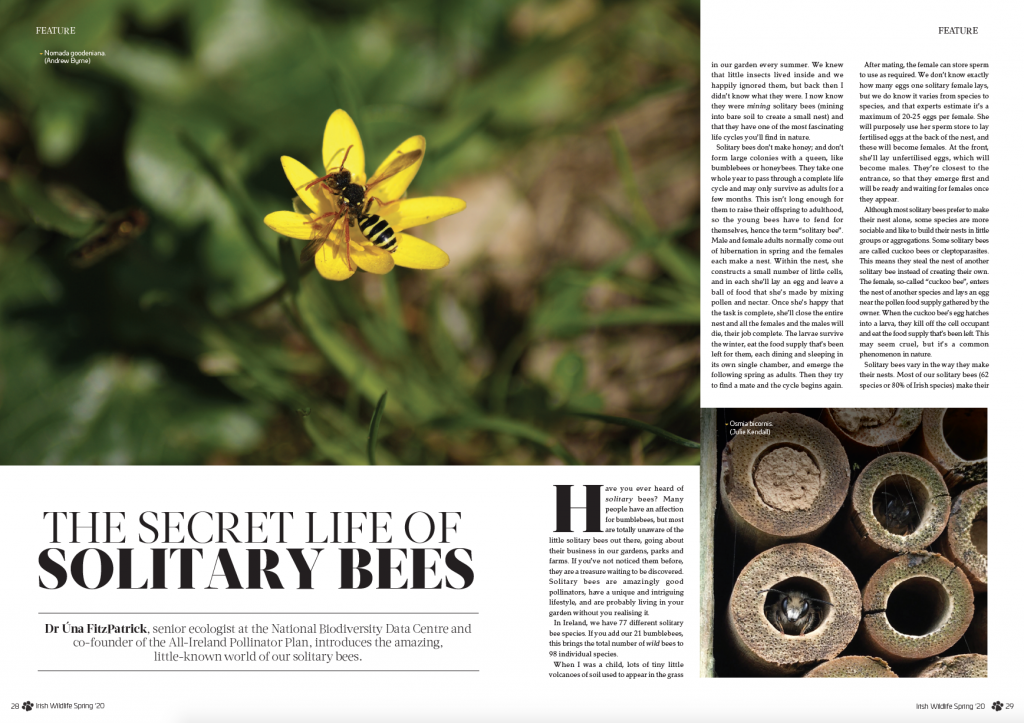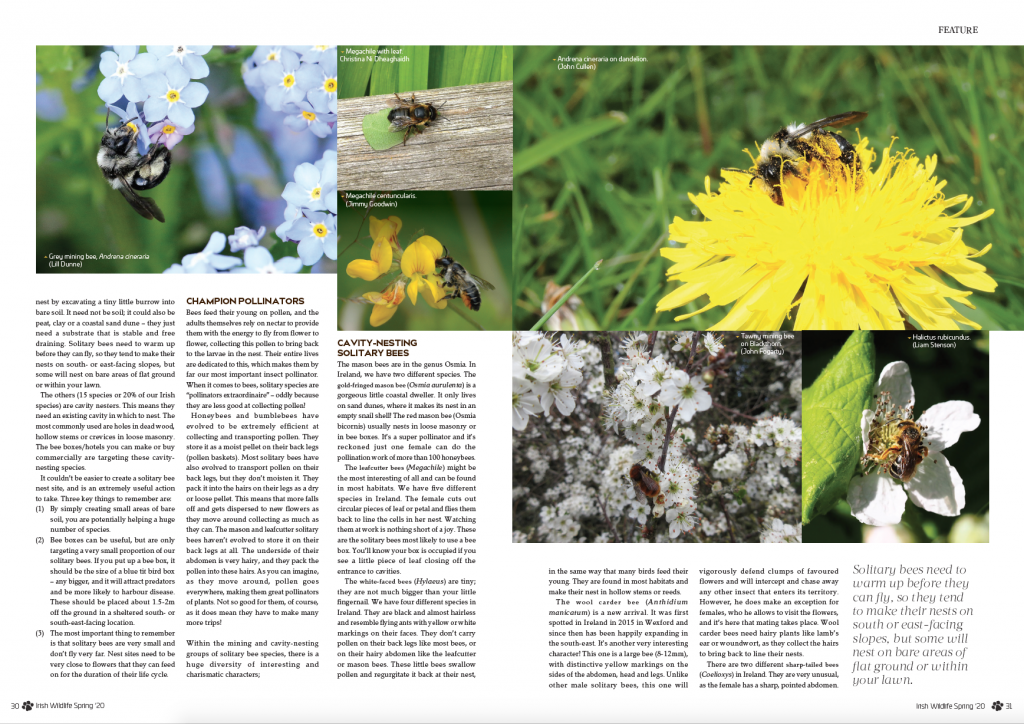Grey Mining Bee (Andrena cineraria) © Lill Dunne
Dr Úna FitzPatrick, Senior Ecologist at the National Biodiversity Data Centre and co-founder of the All-Ireland Pollinator Plan, introduces the amazing, little-known world of our solitary bees.
Have you ever heard of solitary bees?
Many people have an affection for bumblebees, but most are totally unaware of the little solitary bees out there, going about their business in our gardens, parks and farms. If you’ve not noticed them before, they are a treasure trove waiting for you to discover! Solitary bees are amazingly good pollinators, have a unique and intriguing lifestyle, and are probably living in your garden without you realising it.
In Ireland, we have 77 different solitary bee species. If you add our 21 bumblebees, this brings the total number of wild bees to 98 individual species.
As a child, lots of tiny little volcanoes of soil used to appear in the grass in our garden every summer. We knew that little insects lived inside and we happily ignored them, but back then I didn’t know what they were. I now know they were mining solitary bees (mining into bare soil to create a small nest) and that they have one of the most fascinating life cycles you’ll find in nature.
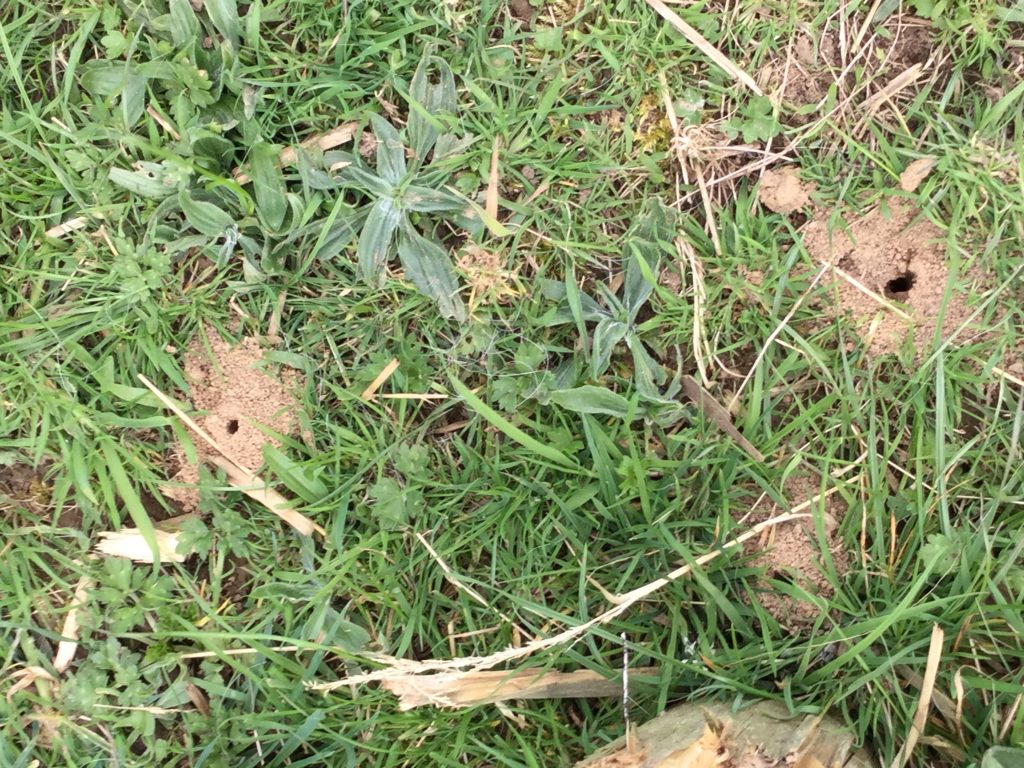 |
 |
|
Nests of Tawny mining bee, Andrena fulva © Anthony Slattery |
Tawny mining bee, Andrena fulva © Jonathan Sexton |
Solitary bees don’t make honey; and don’t form large colonies with a queen, like bumblebees or honeybees. They take one whole year to pass through a complete life cycle and may only survive as adults for a few months. This isn’t long enough for them to raise their offspring to adulthood, so the young bees have to fend for themselves, hence the term ‘solitary bee’. Male and female adults normally come out of hibernation in spring and the females each make a nest. Within the nest she constructs a small number of little cells, and in each she’ll lay an egg and leave a ball of food that she’s made by mixing pollen and nectar. Once she’s happy that the task is complete, she’ll close the entire nest and all the females and the males will die, their job complete. The larvae survive the winter, eat the food supply that’s been left for them, each dining and sleeping in its own single chamber, and emerge the following spring as adults. Then they try to find a mate and the cycle begins again.
After mating, the female can store sperm to use as required. We don’t know exactly how many eggs one solitary female lays. But we do know it varies from species to species, and that experts estimate it’s a maximum of 20-25 eggs per female. She will purposely use her sperm store to lay fertilised eggs at the back of the nest and these will become females. At the front, she’ll lay unfertilised eggs, which will become males. They’re closest to the entrance so that they emerge first and will be ready and waiting for females once they appear.
Although most solitary bees prefer to make their nest alone, some species are more sociable and like to build their nests in little groups or aggregations. Some solitary bees are called cuckoo bees or cleptoparasites. This means they steal the nest of another solitary bee instead of creating their own. The female, so-called ‘cuckoo bee’ enters the nest of another species and lays an egg near the pollen food supply gathered by the owner. When the cuckoo bee’s egg hatches into a larva, they kill off the cell occupant and eat the food supply that’s been left. This may seem cruel, but it’s a common phenomenon in nature.
Solitary bees are amazingly good pollinators,
have a unique and intriguing lifestyle,
and are probably living in your garden without you realising it.
Solitary bees vary in the way they make their nests. Most of our solitary bees (62 species or 80% of Irish species) make their nest by excavating a tiny little burrow into bare soil. It need not be soil; it could also be peat, clay or a coastal sand dune – they just need a substrate that is stable and free draining. Solitary bees need to warm up before they can fly so they tend to make their nests on south or east-facing slopes, but some will nest on bare areas of flat ground or within your lawn.
The others (15 species or 20% of our Irish species) are cavity nesters. This means they need an existing cavity in which to nest. The most commonly used are holes in dead wood, hollow stems or crevices in loose masonry. The bee boxes/hotels you can make or buy commercially are targeting these cavity-nesting species.
It couldn’t be easier to create solitary bee nest site and is an extremely useful action to take. Three key things to remember are:
(1) By simply creating small areas of bare soil you are potentially helping a huge number of species
Bare soil created for mining bees © John Fogarty
(2) Bee boxes can be useful but are only targeting a very small proportion of our solitary bees. If you put up a bee box it should be the size of a Blue Tit bird box – any bigger and it will attract predators and be more likely to harbour disease. These should be placed about 1.5-2m off the ground in a sheltered south or south-east facing location.
(3) The most important thing to remember is that solitary bees are very small and don’t fly very far. Nest sites need to be very close to flowers that they can feed on for the duration of their life cycle.
Champion Pollinators
Bees feed their young on pollen and the adults themselves rely on nectar to provide them with the energy to fly from flower to flower, collecting this pollen to bring back to the larvae in the nest. Their entire lives are dedicated to this, which makes them by far our most important insect pollinator. When it comes to bees, solitary species are ‘pollinators extraordinaire’ – oddly because they are less good at collecting pollen!
Andrena cineraria on Dandelion © John Cullen
Honeybees and bumblebees have evolved to be extremely efficient at collecting and transporting pollen. They store it as a moist pellet on their back legs (pollen baskets). Most solitary bees have also evolved to transport pollen on their back legs, but they don’t moisten it. They pack it into the hairs on their legs as a dry or loose pellet. This means that more falls off and gets dispersed to new flowers as they move around collecting as much as they can. The mason and leaf-cutter solitary bees haven’t evolved to store it on their back legs at all. The underside of their abdomen is very hairy, and they pack the pollen into these hairs. As you can imagine, as they move around, pollen goes everywhere, making them great pollinators of plants. Not so good for them of course, as it does mean they have to make many more trips!
Within the mining and cavity-nesting groups of solitary bee species, there is a huge diversity of interesting and charismatic characters:
Cavity-nesting solitary bees:
The Mason bees are in the genus Osmia. In Ireland, we have two different species. The Gold-fringed mason bee (Osmia aurulenta) is a gorgeous little coastal dweller. It only lives on sand dunes, where it makes it’s nest in an empty snail shell! The Red Mason bee (Osmia bicornis) usually nests in loose masonry or in bee boxes. It’s a super pollinator and it’s reckoned just one female can do the pollination work of more than 100 honeybees.
Osmia bicornis nest site © Julie Kendall
The Leaf-cutter bees (Megachile) might be the most interesting of all and can be found in most habitats. We have five different species in Ireland. The female cuts out circular pieces of leaf or petal and flies them back to line the cells in her nest. Watching them at work is nothing short of a joy. These are the solitary bees most likely to use a bee box. You’ll know your box is occupied if you see a little piece of leaf closing off the entrance to cavities.
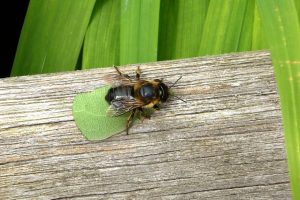 |
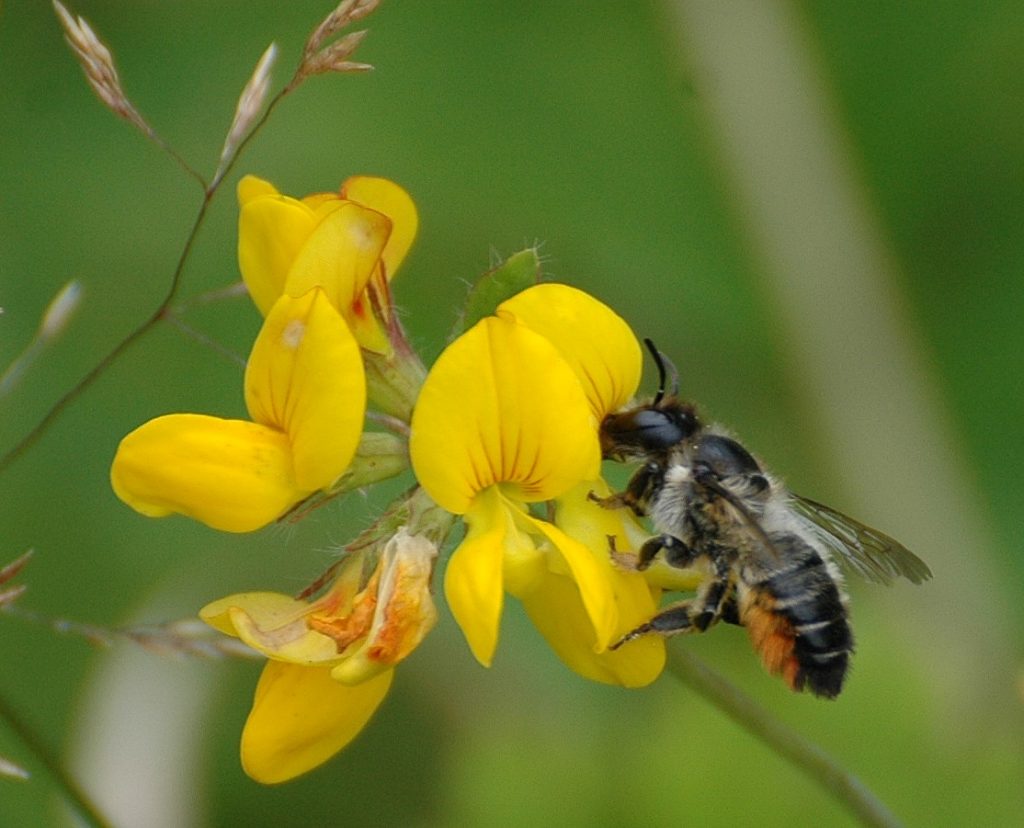 |
|
Megachile carrying leaf back to nest © Christina Ní Dheaghaidh |
Megachile centuncularis © Jimmy Goodwin |
The White-faced bees (Hylaeus) are tiny; they are not much bigger than your little fingernail. We have four different species in Ireland. They are black and almost hairless and resemble flying ants with yellow or white markings on their faces. They don’t carry pollen on their back legs like most bees, or on their hairy abdomen like the leaf-cutter or mason bees. These little bees swallow pollen and regurgitate it back at their nest, in the same way that many birds feed their young. They are found in most habitats and make their nest in hollow stems or reeds.
The Wool carder bee (Anthidium manicatum) is a new arrival. It was first spotted in Ireland in 2015 in Wexford and since then has been happily expanding in the south-east. It’s another very interesting character! This one is a large bee (8-12mm), with distinctive yellow markings on the sides of the abdomen, head and legs. Unlike other male solitary bees, this one will vigorously defend clumps of favoured flowers and will intercept and chase away any other insect that enters its territory. However, he does make an exception for females, who he allows to visit the flowers, and it’s here that mating takes place. Wool carder bees need hairy plants like Lamb’s Ear or Woundwort as they collect the hairs to bring back to line their nests.
Wool Carder Bee © Liam Lysaght
There are two different sharp-tailed bees (Coelioxys) in Ireland. They are very unusual as the female has a sharp, pointed abdomen. They’re a very rare type of cuckoo bee that parasitises the nests of the leaf-cutter species.
The Violet Carpenter bee (Xylocopa violaceae) is the biggest solitary bee in Europe. It nests in dead wood and has been on the move northward in Europe as a result of climate change. It’s only been spotted once in Ireland so far – from Waterford City in 2007.
Mining solitary bees:
The main group of mining bees are in the genus Andrena, which has 26 different species in Ireland. They are found in a variety of habitats and are the solitary bees you’ll most often spot. Keep an eye out for the Ashy mining bee (Andrena cineraria) in spring. This one is very distinctive as its completely black, with grey bands of hair. Clarke’s mining bee (Andrena clarkella) is a fussy eater – the only thing it will feed on is Willow. Willow trees only flower in early spring, so as soon as it has finished flowering, this little bee’s larvae go into hibernation until the following year. The Tawny mining bee (Andrena fulva) recently came back from extinction in Ireland. Before 2012, no one had spotted it for 87 years! It likes to live in gardens, but again you’ll only see it in spring. It burrows into short grass to make its nests, which look like tiny volcanos made of soil.
Andrena fulva on top of its nest © Karen Quinn
The Cuckoo mining bees (genus Nomada) parasitise the nests of Andrena species. There are 12 different species in Ireland. These solitary bees often have black, yellow or red stripes on their abdomen and look like friendly wasps.
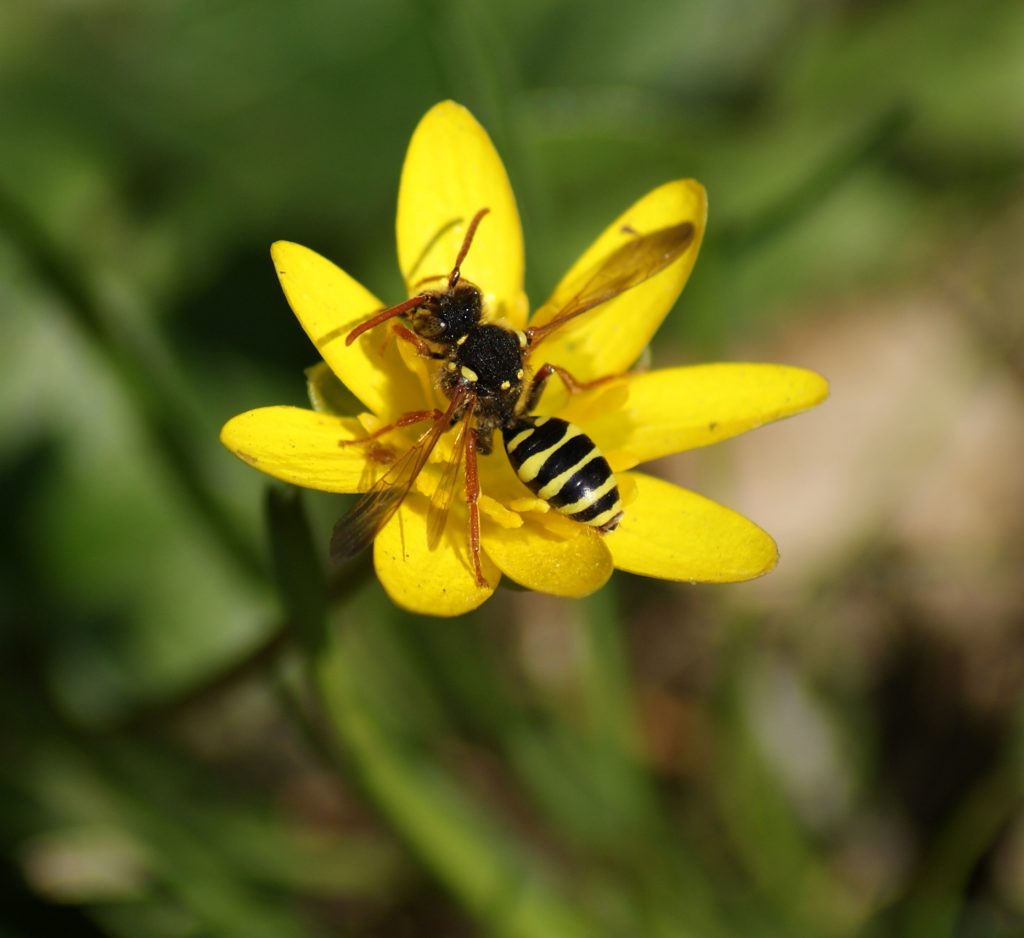
There are four species of Plasterer bee (Colletes) in Ireland. They smooth or plaster the walls of their nest cells using secretions applied with their mouthparts. The Northern Colletes bee (Colletes floralis) is coastal and makes a nest by burrowing into stable banks of sand. Globally, most of the remaining Northern Colletes bees live in Ireland, as they have almost disappeared elsewhere.
There are two different genera of sweat bees in Ireland. We have two species of Halictus and 11 species of Lasioglossum. They are mainly small, black bees that resemble ants with wings. They occur across a variety of habitats and are very difficult to distinguish from each other. They are called sweat bees because it is thought that some are attracted to human sweat, although it has never been reported from Ireland.
Halictus rubicundus © Liam Stenson
There are seven species of blood bees (Sphecodes) in Ireland. These solitary bees are black, with a blood red stripe on the abdomen. They are cuckoo solitary bees who paratitise the nests of sweat bees.
When you begin to learn about solitary bees, one of the things that strikes you most is their intrinsic and fundamental link to the rest of nature. They are totally dependent on climate cues to tell them it’s spring and time to emerge from hibernation – they’re also reliant on those cues being accurate. Unusual events can be catastrophic. If the bees emerge from hibernation too soon, there won’t be food for them to eat and they simply won’t survive. This is a huge problem, as bees tend to respond to temperature increases; whereas for plants it might be increasing day length.
Of our 77 species of solitary bees in Ireland, two have already disappeared and another 24 species are threatened with extinction. Like all our wild bees, solitary bees face many threats, not least hunger. There simply aren’t enough flowers across our increasingly sterile landscapes. The good news is that we can all help, and the All-Ireland Pollinator Plan has been overwhelmed with support across all sectors, from people willing to do exactly that. It’s not difficult and doesn’t cost much – bees simply need food and shelter. But we do all need to get involved – from farms, to councils, local communities, businesses, schools and gardens. If we act, we can change their fate. Keep an eye out this spring or summer, and you might spot solitary bees calmly going about their business as they have done for millions of years. It would be an enormous loss if we didn’t protect that for future generations.
To learn more about the National Biodiversity Data Centre’s recording initiatives and to find out how to help, visit www.pollinators.ie
This article was first published in the Spring issue of Irish Wildlife, the magazine of the Irish Wildlife Trust
Download a PDF of the IWT Irish Wildlife article Spring 2020

